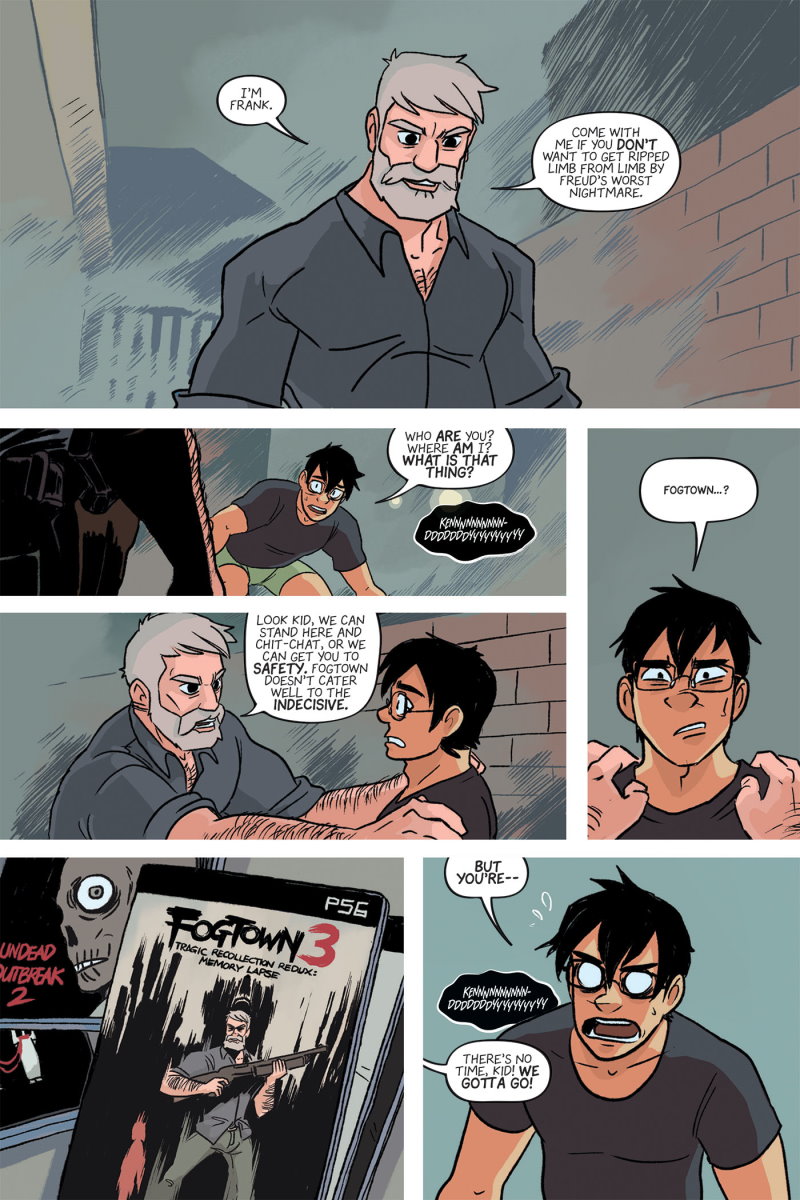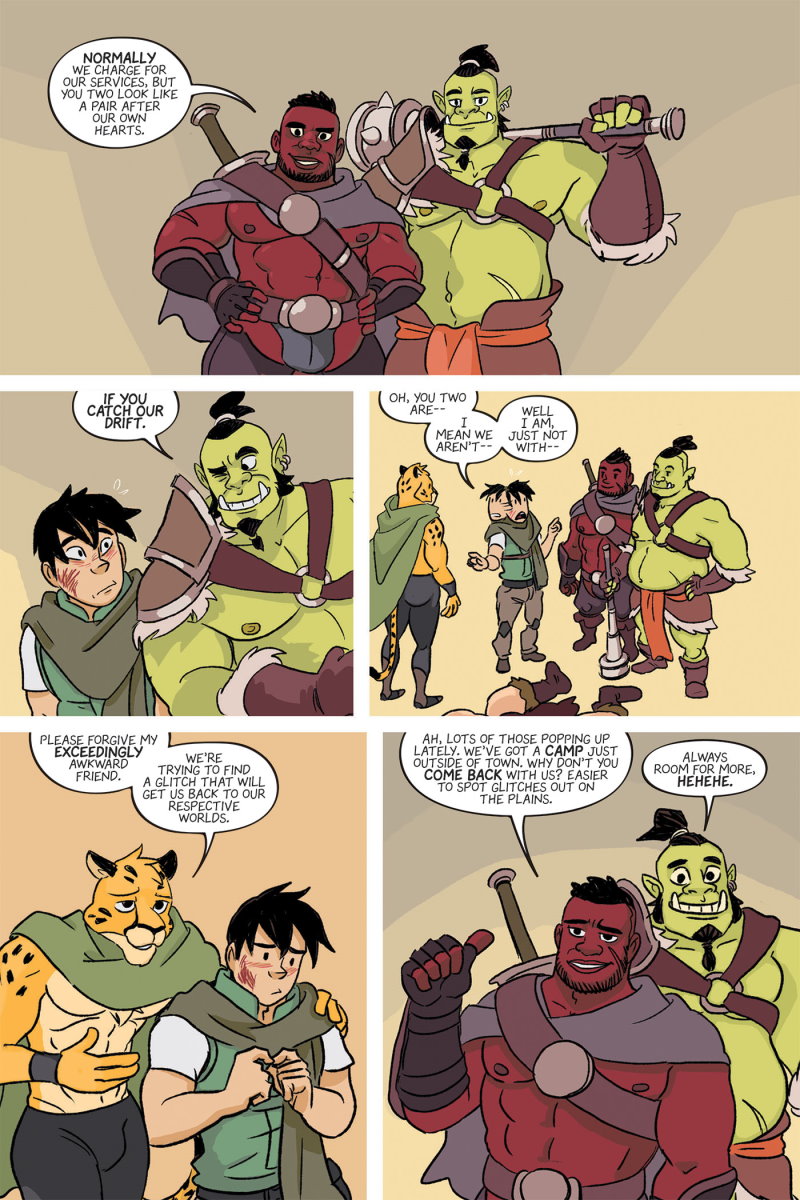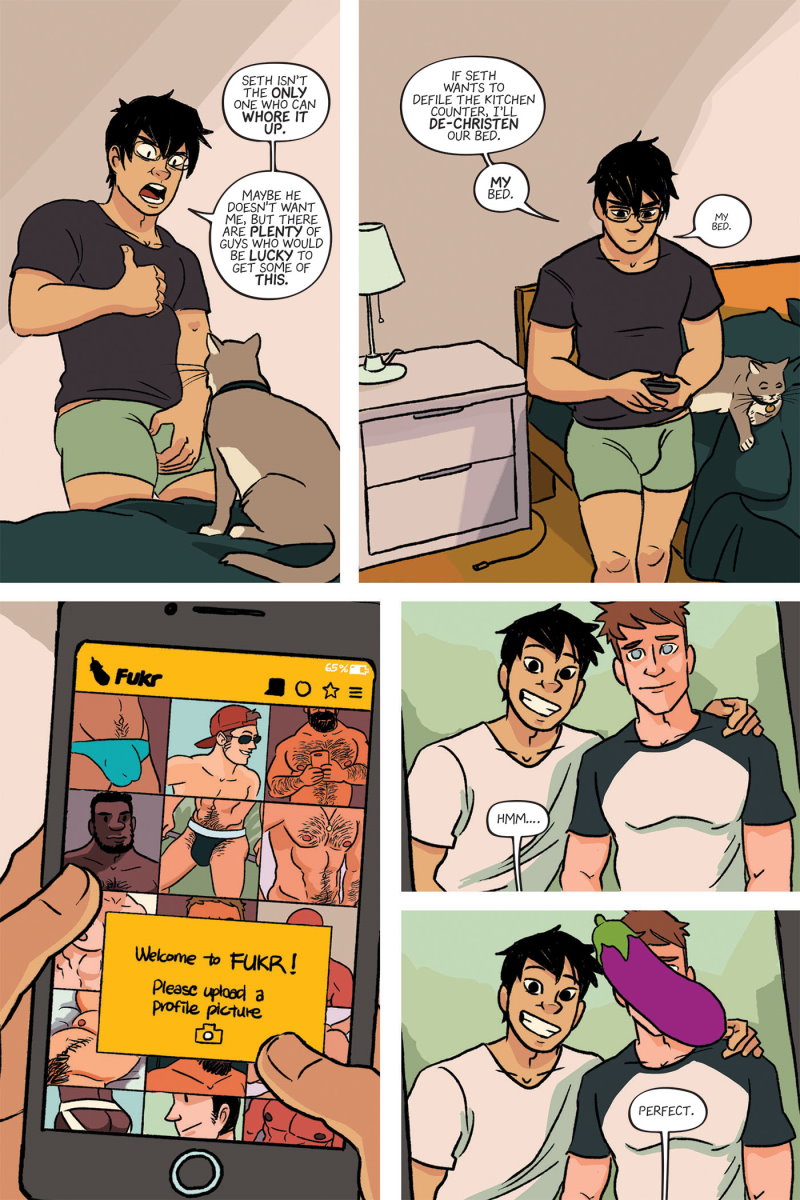'Cheat(er) Code' Creators Examine How the Story Isn’t Just About Sex
Cheat(er) Code is a fun, hot and surprisingly poignant romp. After discovering his long-time partner Seth is cheating on him, Ken seeks solace in his video games. And while this is a fun, beautifully illustrated adult story about banging hot video game characters, it also adeptly covers moving on from those that hurt you. I spoke with the author S.A. Foxe and artist Daryl Toh Liem Zhan about the work.
Warning: This interview (especially the last question) includes spoilers.
If you could only describe Cheat(er) Code in five words, what would they be?
S.A. Foxe: Hmm… not the most informative five-word pitch, but I’d go with: Crasturbate, Cheetah tease, horny orc? That first one is a portmanteau of “crying” and a word you can figure out. These are the most common words readers seem to be reflecting back at me.
Daryl Toh Liem Zhan: Sexy, naughty, funny, emotional and colourful?
What are your favorite video games (and/or the characters you found most attractive)?
SF: My favorite games ever are more innocent than you’d think from reading Cheat(er) Code: I clear my schedule for each new Pokémon release, waste too much time on Overwatch, and dive deep any time an Elder Scrolls game drops. My first system was a SNES, so I still have a lot of love for that era, even though I was pretty awful at everything outside of the Donkey Kong franchise. I get way behind on new releases these days, but I did finally play God of War and the Spider-Man games this past year, and the latter were especially poignant since I can’t really explore NYC IRL right now.
As for attractive characters, I’m dating myself here, but my original video game crush was Zell Dincht from Final Fantasy VIII—I attribute my affection for face tattoos to that JRPG bad boy.
DTLZ: I’m a fan of the first four games in the Silent Hill series, especially Silent Hill 2 and the amazing soundtracks by Akira Yamaoka. Other notable favorites are Fatal Frame and Resident Evil 2, but also games like Uncharted, Little Nightmares, Journey, ABZU and Rime.
Attractive characters…. Pyramid Head from Silent Hill 2. Yes.

How did you develop the designs for Cheat(er) Code’s pastiche characters?
SF: From the start, Cheat(er) Code has been an international affair. I’m in New York, Daryl is in Malaysia, and Ari Yarwood, our editor, is in Portland, so it takes one full day for us all to actually wake up, respond to emails, and keep the process rolling. Ari suggested Daryl as our first choice, and I don’t think she could have guessed what a truly perfect fit he would be, since his style fits the material, he already had experience with erotica, and he’s a gamer himself.
I’ve worked on projects where the artist isn’t familiar with any of the references I’m pulling from—which can work, but takes a lot of extra effort—so it was a huge relief that Daryl grew up with all the same gaming touchstones that inspired me. Having that shorthand from the start saved us both so much time, and let us focus on Kennedy’s emotional arc and the sexy fun-times, instead of having to explain Easter eggs to each other.
Daryl’s gaming experience fundamentally shaped the book, too. Even though I’m a huge horror buff, I had never thought to fold in survival-horror inspirations like Silent Hill and Resident Evil until Daryl suggested it. You’d think horror would kill the mood, but it ended up being the perfect transition into the game-world part of the book, and Daryl’s take on some psychosexual horrors are the perfect midpoint between terror and visual gag.
In fact, I don’t think Ari or I had much visual feedback for Daryl at all, beyond a group conversation about representing different body types in the book. I write full-script most of the time, but I think the magic happens in comics when writers back off and let artists create and follow their own inspirations. The finished book has a bunch of video game nods that I scripted, but just as many that Daryl suggested or hid in the margins.
There’s a spread near the end, in particular, that still makes me laugh out loud, even after seeing it 50 bajillion times in the bookmaking process. I’ll never look at a certain famous plumber or wildly successful block-building game the same way again.
DTLZ: When Ari approached me with this project, I was honestly wasn’t
sure if my style could really do justice to Steve’s vision for the
story. But I knew I couldn’t let this opportunity pass. I mean, it’s not
every day you get to draw or come up with character designs of your
favorite video game characters in an erotica and go wild with it!
Like Steve mentioned—and he’s too kind—not only did I understand all the
references he’s pulling from these video games, but his draft was
detailed enough for me to immediately flesh out the characters visually.
For example, some of the main video game characters were an amalgamation of traits or design elements. Frank from ‘Fogtown’ is a parody and homage of the three main protagonists from Resident Evil, Silent Hill and The Last of Us. Dash the Cheetah was probably the toughest for me, mainly because I don’t really draw animals or anthropomorphic characters quite often. He’s a combination of Sonic and Crash Bandicoot, but he has to be hot, confusingly attractive—like how we see adult Simba in The Lion King kind of hot!
In addition to that, the creative freedom I got from Steve and Ari was a big help in finalizing the design process and advanced production. However, there are a few occasions where some of the character designs were only fully developed during the inking and coloring phase of the production.
Did you always intend to make Cheat(er) Code an explicit, adult work, or did that come into play as you developed the book?
SF: Cheat(er) Code came about specifically because I got the opportunity to pitch for an explicit, adult imprint, and I’m not sure I ever would have told a version of this story otherwise. But I knew from the jump that I couldn’t write just for arousal, because we all have access to an overwhelming amount of content like that online as it is.
If someone is going to pay for and read an 18+ OGN, the story really has to hold your attention between those explicit scenes. I think you could do a version of Cheat(er) Code that obscured the actual sexy bits, but you’d lose a lot of the fun and unexpected charm of the whole package [winks].
As someone who’s worked on both erotic and not-erotic works, how is the process for publishing/writing/drawing erotica different (if at all)?
SF: Not only was Cheat(er) Code my first (and to date, only) erotic work, but most of my published writing up until I pitched it was exclusively for kids! And on some level, writing a story is writing a story—you still have to have the structure and care you would for a book without steamy scenes.
But it was extremely intimidating, and not a little bit embarrassing, to write out the stage directions for sex scenes to email to two people I had never met in person, one of whom would then follow my script to visually depict encounters I made up, motion by motion, in my head. It could have gone gloriously wrong, but Daryl was luckily on the right wavelength to envision what I wrote out and make it that much better.
DTLZ: Steve got off easy on the little bit embarrassing part [laughs]. It’s also my first venture into a full erotic book, which really is an interesting set of visual challenges. I get to draw various genres from drama, horror, fantasy and sci-fi in each chapter, or level, as the story progresses with steamy scenes. On a side note, since I work from home and live with my family and share the office space, it’s also stressfully funny to make sure none of them walk in and look at my screen and catch me drawing a raunchy gay threesome with an orc!

How did you develop the story and ground it, while still committing to the somewhat over-the-top premise?
SF: One of the great things about over-the-top premises is that the reader is either in or out—there isn’t a lot of middle ground. If Cheat(er) Codedidn’t immediately go to that heightened, kind of ridiculous place of, say, a lightning strike traveling through a certain fluid to send you into the digital realm, then I could see readers waffling a bit on whether or not the book was working for them once we did get to the game stuff. But since the first 20 pages give you a pretty accurate overview of the tones we’re balancing, I think we weed out unsure readers pretty quickly.
As for keeping the heart of the story itself, that’s something I’ve tried to imitate after seeing it in all sorts of my favorite genre stories, from old Vertigo comics to surreal horror to progressive sci-fi. If you give the reader human emotions and feelings to anchor them, you can get real weird—or real goofy and sexy and nerdy. And while Ken’s story is definitely not one-to-one with my own experiences, I pitched Cheat(er) Code not long after the unexpected (but thankfully not adulterous) end of a long-term relationship, so I was filtering some of my own raw feelings into Ken’s situation with Seth.
DTLZ: It’s all in Steve’s script, and the emotional anchor that is Ken, our main protagonist. We have to make sure what I drew is also emotionally faithful to what Steve has written; that the moment readers meet Ken in the first chapter, they are ready to follow him to find his bittersweet, happy ending.

Why was it important for Ken and Dash NOT to hook up, even though the story seems headed that way when Dash is first introduced?
SF: Yeah, mild spoiler alert, and apologies to the furry community, but there was never a version of Cheat(er) Code where Kennedy and Dash hooked up, even though there’s a lot of teasing throughout. Dash sort of guides Kennedy through his saga, and even though he’s a sexy anthropomorphic cheetah, he helps ground Ken and keep him focused while all the crazy sexy stuff is happening. It’s natural that Kennedy, when thrown into such an unstable situation—both in the video game world and with his breakup—would cling to that rock in the storm that Dash represents, which is exactly why I couldn’t let them hook up.
I think there’s a very common, relatable phenomenon wherein you end up considering platonic friends as romantic or sexual partners after a bad breakup, because that’s a human being who’s there for you and supporting you through something challenging. And while there are plenty of scenarios where you might end up in a healthy romantic or sexual relationship with that formerly platonic friend, I think there are just as many more where you end up realizing, oh no, you were misplacing affection because you were in a vulnerable position.
So as much as Kennedy’s journey is about overcoming his ex and becoming his own person, the arc Kennedy has with Dash—who plays the role of an old, consistent friend because Kennedy has played so many of Dash’s games over the years—is sort of the check and balance to Kennedy having this no-holds-barred sexual adventure. We need supportive platonic friends in our lives, too, even (especially?) if they’re humanoid felines.
DTLZ: I love the cheeky sexual tension Steve brings into Dash, both for Ken and to mess with readers. But I do love that platonic bromance they have in the end. I’m sorry too, furry fans, I DID draw the two of them kissing in the double spread montage, in the final chapter (ahem) but I had to remove it.
Cheat(er) Code is available from Oni Press, or from your local bookshop.